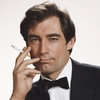Raymond Durgnat might seem obscure next to Roger Ebert, but for many he was the “critic’s critic,” highly valued for his erudition and ability to contextualize any film in front of him. This review of The Living Daylights appeared in the Aug. 1, 1987 issue of the Monthly Film Bulletin and stands as one of the most perceptive socio-political examinations of Dalton’s debut:
In the quarter-century since Dr. No (1962), the Bond films have increasingly opted for a mood of nail-biting exuberance, closer to the old serial spirit—somewhere between The Perils of Pauline and The Mask of Fu Manchu—than to Len Deighton or John Le Carré. Q's death-dealing gadgetry is often as hilarious as it is awesome; the stunts generate a festive air, like a three-ring circus; Bond's seduction of, and by, the various Bond girls has less to do with the serious business of espionage than with the daydreams of cheery virility; and the extravagant villains, with their grandiose schemes for world disruption, have a built-in improbability which, while it never prevents suspense from breaking in, subverts any real suspension of disbelief. Descriptions like ‘camp’, ‘tongue-in-cheek’, or ‘winking at the audience’ risk understating these films’ appurtenance to a curiously overlooked genre: the self-aware spectacle, whose happy self-reflexivity, far from ‘subverting the illusion’, actually celebrates the show qua show.
The original Bond novels (from 1952) are interesting enough, at least by the standards of what one might call ‘easy reading’ or ‘upmarket pulp fun’. They mix a toughly patriotic gentleman-spy with new perceptions of politico-bureaucratic cynicism; old snobberies with modern affluence-and-anomie; Sapper with Nigel Balchin. Probably Bond's secret agenting does metaphor a new sense of social life as continuous deception all round. Compared to the novels, the movies are brasher, broader and more down-market. The Roger Moore Bond, in particular, far from seeming secretive, had all the swagger of a car salesman relishing an unexpectedly huge expense account.
While Fleming's novels contained a stiff mix of chauvinism and realpolitik—in a phrase, the spirit of Eden at Suez—the movies merely perpetuate the cocky hedonism inaugurated with the Swinging Sixties (The Avengers amidst the Playboy ‘philosophy’). The more relaxed screen tone usually extends as far as a worldly tolerance of Russia's adversarial role. The enemy No. One is rarely World Communism, but mischief-making by egomaniacal, often conspicuously capitalistic, masterminds. In Billion Dollar Brain, a ‘cousin’ to the Bond films, via their co-producer Harry Saltzman, the same basic formula tilts in favour of Russian imperialism against U.S. interventionism; and the final flourish on behalf of detente in For Your Eyes Only was audibly protested by a London preview audience, impressed by the invasion of Afghanistan.
Although The Living Daylights involves heavier references to Second World oppression (not inappropriate in a Czechoslovakian setting), it eschews any further concessions to Cold War revival, Rambo-style, instead attributing trouble to collusion between deviationist ultras on both sides. (A significant omission: Libyans, in the style of Back to the Future.) Here, Afghanistan, ambivalence and amorality call the tune. If the plot is rarely coherent, let alone plausible, its penultimate twists are quite fascinating. They happily mix, into a moral chiaroscuro worthy of Machiavelli himself, [a] a mercenary-capitalist dressed as a U.S. general (virtually an incarnation of the ‘contra’ spirit), [b] a Russian equivalent of Irangate, and [c] freedom fighters who keep going by dealing dope. Almost as a compensatory concession to our finer feelings, Bond’s affair with the gentle, doe-eyed, cello-playing victim of love is more sensitive than heretofore, even faintly romantic. The new, Timothy Dalton version of Bond is relatively sleek, tough and thoughtful; his occasional flash of a fey, pixie-ish expression oddly evokes another multimorphous British hero, Dr. Who.
Until the ‘Afghanisgate’ revelations, the film rather suffers from its imperfect compromise between the usual spectacular elements, which can be exhilarating however implausible, and its more intimate, smaller-scale tendencies, à la Frederick Forsyth, where an air of horrid ingenuity is indispensable. But if the film probably won't be among the biggest-grossing Bonds, it contains some highly enjoyable set-pieces, notably, the hilarious notion of whisking a fugitive along a pipeline as if he were a pneumatique, and the penultimate rodeo mixing cavalry and aircraft, bulldozers and saboteurs, all performing wildly eccentric manoeuvres. The film is essentially an ‘action circus’, Douglas Fairbanks swashbuckle updated by secret-agent costume (cloak-and-gadget), and sex-with-everything. No doubt its good humour is beginning to seem slightly dated by contrast with the rather grimmer (and, in physical violence, more savagely detailed) tone of the otherwise comparable Indiana Jones sagas.
Edited by Revelator, 07 March 2017 - 07:52 PM.





